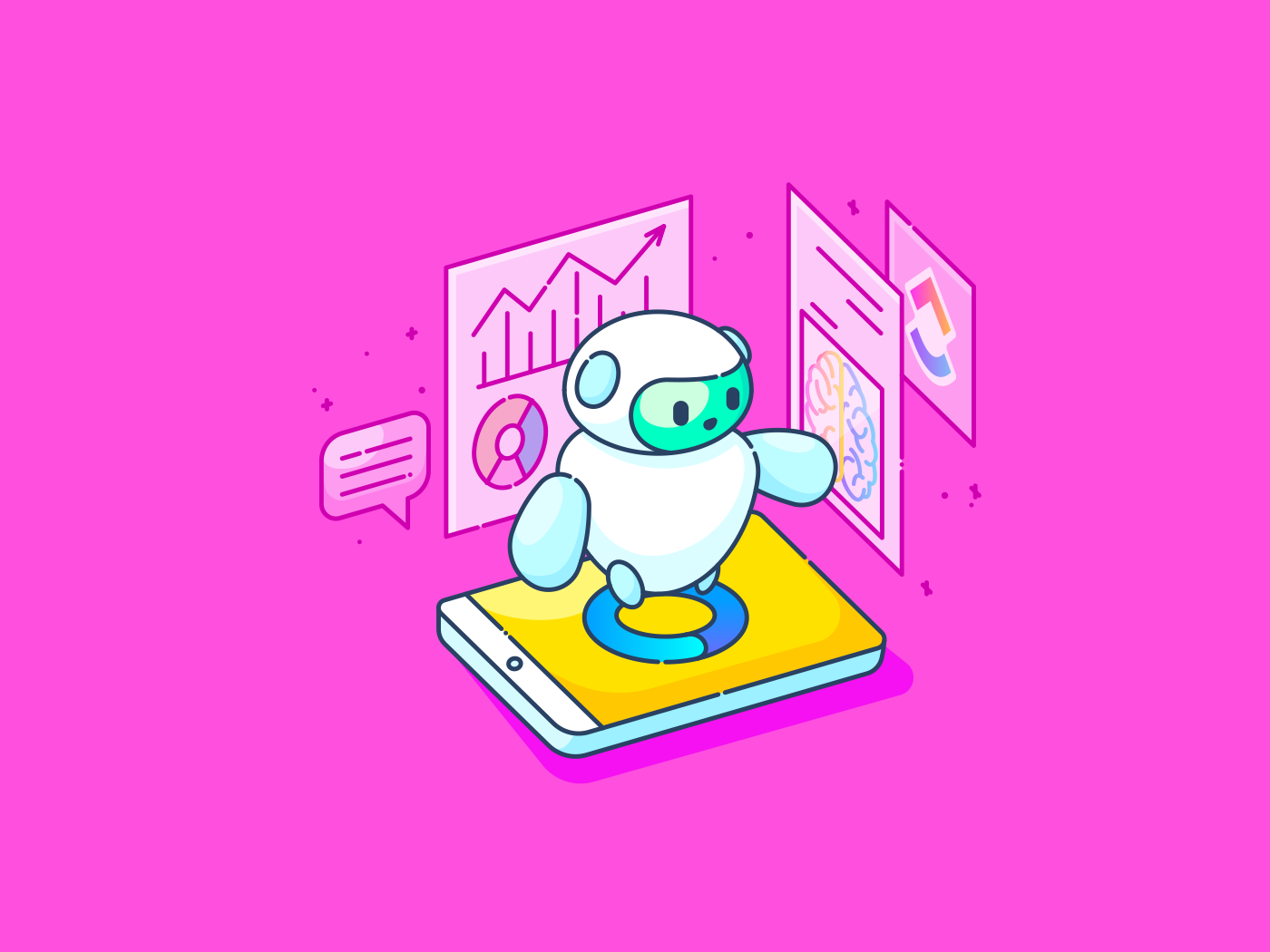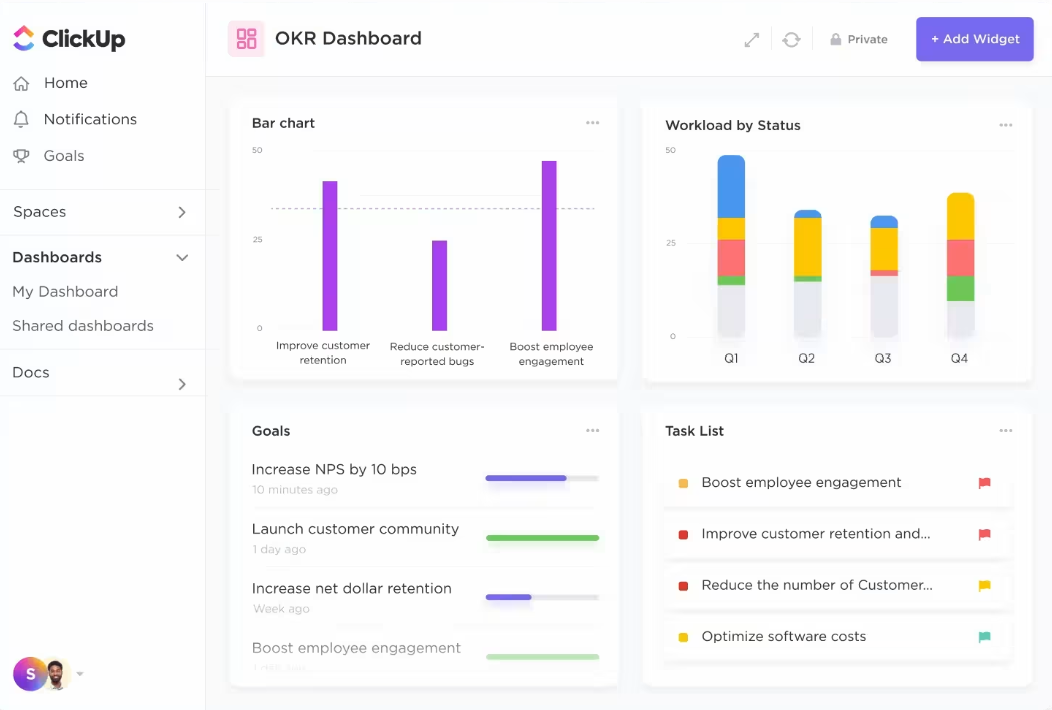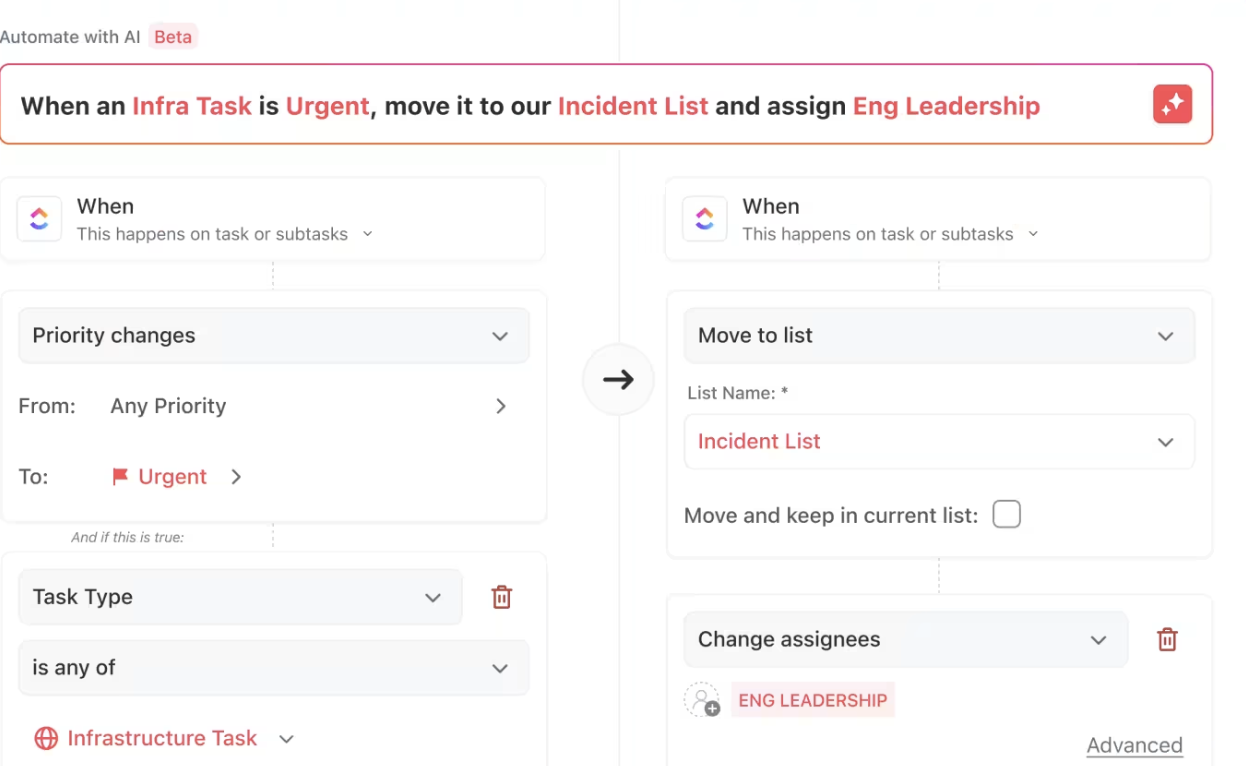Learning Agents in AI: Essential Components & Processes (Types, Applications, and More)

Sorry, there were no results found for “”
Sorry, there were no results found for “”
Sorry, there were no results found for “”
A customer service bot that learns from every interaction. A sales assistant that tweaks its strategy based on real-time insights. These aren’t just concepts—they’re real, thanks to AI learning agents.
In ClickUp, this same idea shows up as Super Agents, AI teammates that use learning loops to own outcomes across multi-step workflows instead of stopping at a single response.
But what makes these agents unique, and how does a learning agent function to achieve this adaptability?
Unlike traditional AI systems that operate with fixed programming, learning agents evolve.
They adapt, improve, and refine their actions over time, making them indispensable for industries like autonomous vehicles and healthcare, where flexibility and precision are non-negotiable.
Think of them as AI that grows smarter with experience, just like humans.
In this blog, we’ll explore the key components, processes, types, and applications of learning agents in AI. 🤖
Here’s a quick primer on learning agents in AI:
What They Do: Adapt through interactions, e.g., customer service bots refining responses.
Key Uses: Robotics, personalized services, and smart systems like home devices.
Core Components:
Learning Methods:
Real-World Impact: Enhances adaptability, efficiency, and decision-making in various industries.
⚙️ Bonus: Feeling overwhelmed by AI jargon? Check out our comprehensive glossary of AI terms to easily understand basic concepts and advanced terminology.
Learning agents in AI are systems that improve over time by learning from their environment. They adapt, make smarter decisions, and optimize actions based on feedback and data.
Unlike traditional AI systems, which remain fixed, learning agents continuously evolve. This makes them essential for robotics and personalized recommendations, where conditions are unpredictable and constantly changing.
🔍 Did You Know? Learning agents operate in a feedback loop—perceiving the environment, learning from feedback, and refining their actions. This is inspired by the way humans learn from experience.
Learning agents are typically composed of several interconnected components working together to ensure adaptability and improvement over time.
Here are some critical components of this learning process. 📋
The core responsibility of the agent is to acquire knowledge and improve performance by analyzing data, interactions, and feedback.
Using AI techniques such as supervised, reinforcement, and unsupervised learning, the agent adapts and updates its behavior to enhance its functionality.
📌 Example: A virtual assistant like Siri learns user preferences over time, such as frequently used commands or specific accents, to provide more accurate and personalized responses.
This component executes tasks by interacting with the environment and making decisions based on available information. It’s essentially the ‘action arm’ of the agent.
📌 Example: In autonomous vehicles, the performance element processes traffic data and environmental conditions to make real-time decisions, such as stopping at a red light or avoiding obstacles.
The critic evaluates the actions taken by the performance element and provides feedback. This feedback helps the learning element identify what worked well and needs improvement.
📌 Example: In a recommendation system, the critic analyzes user interactions (like clicks or skips) to determine which suggestions were successful and helps the learning element refine future recommendations.
This component encourages exploration by suggesting new scenarios or actions for the agent to test.
It pushes the agent beyond its comfort zone, ensuring continuous improvement. The agent also prevents suboptimal outcomes by expanding the agent’s range of experience.
📌 Example: In eCommerce AI, the problem generator might suggest personalized marketing strategies or simulate customer behavior patterns. This helps the AI refine its approach to deliver recommendations tailored to different user preferences.
Learning agents primarily rely on three key categories to adapt and improve. These have been outlined below. 👇
The agent learns from labeled datasets, where each input corresponds to a specific output.
This method requires a large volume of accurately labeled data for training and is widely used in applications such as image recognition, language translation, and fraud detection.
📌 Example: An email filtering system learns to classify emails as spam or not based on historical data. The learning element identifies patterns between inputs (email content) and outputs (classification labels) to make accurate predictions.
Hidden patterns or relationships in data emerge as the agent analyzes information without explicit labels. This approach works well for detecting anomalies, creating recommendation systems, and optimizing data compression.
It also helps identify insights that might not be immediately visible with labeled data.
📌 Example: Customer segmentation in marketing can group users based on their behavior to design targeted campaigns. The focus is on understanding structure and forming clusters or associations.
Unlike the above, reinforcement learning (RL) involves agents taking actions in an environment to maximize cumulative rewards over time.
The agent learns by trial and error, receiving feedback through rewards or penalties.
🔔 Remember: The choice of learning method depends on the problem, data availability, and environment complexity. Reinforcement learning is vital for tasks without direct supervision, as it uses feedback loops to adapt actions.
🧠 Fun Fact: Learning agents have defeated human champions in games like Chess and Starcraft, showcasing their adaptability and intelligence.
Q-learning is a widely used RL algorithm where agents learn the value of each state-action pair through exploration and feedback. The agent builds a Q-table, a matrix that assigns expected rewards to state-action pairs.
It chooses the action with the highest Q-value and refines its table iteratively to improve accuracy.
📌 Example: An AI-powered drone learning to deliver packages efficiently uses Q-learning to evaluate routes. It does so by assigning rewards for on-time deliveries and penalties for delays or collisions. Over time, it refines its Q-table to choose the most efficient and safe delivery paths.
However, Q-tables become impractical in complex environments with high-dimensional state spaces.
Neural networks step in here, approximating Q-values instead of explicitly storing them. This shift enables reinforcement learning to tackle more intricate problems.
Deep Q-networks (DQNs) take this further, leveraging deep learning to process raw, unstructured data like images or sensor inputs. These networks can directly map sensory information to actions, bypassing the need for extensive feature engineering.
📌 Example: In self-driving cars, DQNs process real-time sensor data to learn driving strategies, such as lane changes or obstacle avoidance, without pre-programmed rules.
These advanced methods enable agents to scale their learning capabilities to tasks requiring high computational power and adaptability.
⚙️ Bonus: Learn how to create and refine an AI knowledge base that streamlines information management, improves decision-making, and boosts team productivity.
The learning process for agents values crafting strategies for intelligent decision-making in real-time. Here are key aspects that assist decision-making:
🎤 Podcast Alert: Go through our curated list of popular AI podcasts to deepen your understanding of learning agents’ operations.
Learning agents in artificial intelligence come in various forms, each tailored to specific tasks and challenges.
Let’s explore their working mechanisms, unique characteristics, and real-world examples. 👀
Such agents respond directly to stimuli based on predefined rules. They use a condition-action (if-then) mechanism to choose actions based on the current environment without considering the history or future.
A thermostat functions as a simple reflex agent by turning on the heating when the temperature falls below a set threshold and turning it off when it rises. It makes decisions purely based on current temperature readings.
🧠 Fun Fact: Some experiments assign learning agents simulated needs like hunger or thirst, encouraging them to develop goal-oriented behaviors and learn how to meet these “needs” effectively.
These agents maintain an internal model of the world that allows them to consider the effects of their actions. They also infer the state of the environment beyond what they can immediately perceive.
A Tesla self-driving car utilizes a model-based agent to navigate roads. It detects visible obstacles and predicts the movement of nearby vehicles, including those in blind spots, using advanced sensors and real-time data. This lets the car make precise and informed driving decisions, enhancing safety and efficiency.
🔍 Did You Know? The concept of learning agents often mimics behaviors observed in animals, such as trial-and-error learning or reward-based learning.
These agents operate in digital environments and perform specific tasks autonomously.
Virtual assistants like Siri or Alexa process user inputs using natural language processing (NLP) and execute actions like answering queries or controlling smart devices.
Alexa can play music, set reminders, and control smart home devices by interpreting voice commands, connecting to cloud-based systems, and executing appropriate actions.
🔍 Did You Know? Utility-based agents, which focus on maximizing outcomes by evaluating different actions, often work alongside learning-based agents in AI. Learning agents refine their strategies over time based on experience, and they can use utility-based decision-making to make smarter choices.
These systems consist of multiple interacting agents cooperating, competing, or working independently to achieve individual or collective goals.
In addition, game theory principles often guide their behavior in competitive scenarios.
In Amazon’s warehouse automation system, robots (agents) work collaboratively to pick, sort, and transport items. These robots communicate with each other to avoid collisions and ensure smooth operations. Game theory principles help manage competing priorities, like balancing speed and resources, to ensure the system operates efficiently.
Learning agents have transformed numerous industries by improving efficiency and decision-making.
Here are some key applications. 📚
Learning agents are at the core of modern robotics, allowing robots to operate autonomously and adaptively in dynamic environments.
Unlike traditional systems that require detailed programming for each task, learning agents allow robots to self-improve through interaction and feedback.
Robots equipped with learning agents use techniques like reinforcement learning to interact with their surroundings and evaluate the results of their actions. They refine their behavior over time, focusing on maximizing rewards and avoiding penalties.
Neural networks take this further, allowing robots to process complex data like visual inputs or spatial layouts, facilitating sophisticated decision-making.
📖 Also Read: AI Hacks That Make You Faster, Smarter, and Better
Learning agents power simulations that offer a cost-effective, risk-free way to study complex systems.
These systems replicate real-world dynamics, predict outcomes, and optimize strategies by modeling agents with distinct behaviors and adaptive capabilities.
Learning agents in simulations observe their environment, test actions, and adjust their strategies to maximize effectiveness. They continuously learn and improve over time, enabling them to optimize outcomes.
Simulations are highly effective in supply chain management, urban planning, and robotics development.
💡 Pro Tip: Optimize data preprocessing in AI machine learning to improve the accuracy and efficiency of learning agents. High-quality input ensures more reliable decision-making.
Learning agents drive intelligent systems by enabling real-time data processing and adaptation to user behavior and preferences.
From smart appliances to autonomous cleaning devices, these systems transform how users interact with technology, making everyday tasks more efficient and personalized.
Devices like the Roomba use onboard sensors and learning agents to map home layouts, avoid obstacles, and optimize cleaning routes. They constantly collect and analyze data—such as areas requiring frequent cleaning or furniture placement—enhancing their performance with each use.
These intelligent systems highlight the practical applications of learning agents in everyday life, such as streamlining workflows and automating repetitive tasks for improved efficiency.
🔍 Did You Know? Roomba collects over 230,400 data points per second to map your home.
Learning agents are instrumental in enhancing online interactions and digital assistance. They enable forums and virtual assistants to deliver personalized experiences.
Learning agents moderate discussions in forums and identify and remove spam or harmful content. Interestingly, they also recommend relevant topics to users based on their browsing history.
AI virtual assistants like Alexa and Google Assistant use learning agents to process natural language inputs, improving their contextual understanding over time.
⚙️ Bonus: Learn how to use AI in your workplace to boost productivity and streamline tasks with intelligent agents.
Developing learning agents involves technical, ethical, and practical challenges, including algorithm design, computational demands, and real-world implementation.
Let’s look at some key challenges AI development faces as it evolves. 🚧
Learning agents face the dilemma of balancing exploration and exploitation.
Though algorithms like epsilon-greedy can assist, achieving the right balance is highly context-dependent. Moreover, excessive exploration can result in inefficiency, while over-reliance on exploitation may produce suboptimal solutions.
Training sophisticated learning agents often requires extensive computational resources. This is more applicable in environments with complex dynamics or large state-action spaces.
Remember that algorithms such as reinforcement learning with neural networks, like Deep Q-Learning, demand significant processing power and memory. You’ll need help with making real-time learning practical for resource-constrained applications.
Scaling learning agents to operate effectively in large, multi-dimensional environments remains challenging. Transfer learning, where agents apply knowledge from one domain to another, is still in its infancy.
This has limited their ability to generalize across tasks or environments.
📌 Example: An AI agent trained for chess would struggle with Go due to vastly different rules and objectives, highlighting the challenge of transferring knowledge across domains.
The performance of learning agents heavily depends on the quality and diversity of training data.
Insufficient or biased data can lead to incomplete or erroneous learning and result in suboptimal or unethical decisions. Additionally, collecting real-world data for training can be expensive and time-consuming.
⚙️ Bonus: Explore AI courses to enhance your understanding of other agents.
Developers and researchers rely on various tools to build and train learning agents. Frameworks like TensorFlow, PyTorch, and OpenAI Gym offer foundational infrastructure for implementing machine learning algorithms.
These tools also help create simulated environments. Some AI apps also simplify and enhance this process.
For traditional machine learning approaches, tools like Scikit-learn remain reliable and effective.
For managing AI research and development projects, ClickUp offers more than task management—it acts as a centralized hub for organizing tasks, tracking progress, and enabling seamless collaboration across teams.

ClickUp for AI Project Management reduces manual efforts spent assessing task statuses and allocating duties.
Instead of manually checking in on each task or figuring out who’s available, AI does the heavy lifting. It can automatically update progress, identify bottlenecks, and suggest the best person for each task based on their workload and skills.
This way, you spend less time on tedious admin and more time on what matters—moving your projects forward.
Here are some AI-powered features that stand out. 🤩
ClickUp Brain, an AI-powered assistant built into the platform, simplifies even the most complex projects. It breaks down extensive studies into manageable tasks and subtasks, helping you stay organized and on track.
Need quick access to experimental results or documentation? Just type a query, and ClickUp Brain retrieves everything you need in seconds. It even lets you ask follow-up questions based on existing data, making it feel like your personal assistant.
Plus, it automatically links tasks to relevant resources, saving you time and effort.
Let’s say you’re conducting a study on how reinforcement learning agents improve over time.
You have multiple stages—literature review, data collection, experimentation, and analysis. With ClickUp Brain, you can ask, ‘Break this study into tasks,’ and it will automatically create subtasks for each phase.
You can then ask it to pull up relevant papers on Q-learning or fetch datasets on agent performance, which it does instantly. As you work through the tasks, ClickUp Brain can link specific research articles or experiment results directly to the tasks, keeping everything organized.
Whether tackling research frameworks or everyday projects, ClickUp Brain ensures you work smarter, not harder.

ClickUp Automations is a simple yet powerful way to streamline your workflow.
It enables instant task assignments once prerequisites are completed, notifies stakeholders about progress milestones, and flags delays—all without manual intervention.
You can also use commands in natural language, making workflow management even easier. There is no need to dive into complex settings or technical jargon—just tell ClickUp what you need, and it will create the automation for you.
Whether it’s ‘move tasks to the next stage when they’re marked complete’ or ‘assign a task to Sarah when the priority is high,’ ClickUp understands your request and sets it up automatically.
📖 Also Read: How to Use AI for Productivity (Use Cases & Tools)
To build AI learning agents, you will need an expert mix of structured workflows and adaptive tools. The added demand for technical expertise makes it all the more challenging, especially considering such tasks’ statistical and data-backed nature.
Consider using ClickUp to streamline these projects. Beyond mere organization, this tool supports your team’s innovation by removing avoidable inefficiencies.
ClickUp Brain helps break down complex tasks, retrieve relevant resources instantly, and offer AI-powered insights to keep your projects organized and on track. Meanwhile, ClickUp Automations handles repetitive tasks, like updating statuses or assigning new tasks, so your team can focus on the bigger picture.
Together, these features remove inefficiencies and allow your team to work smarter, making innovation and progress effortless.
Sign up to ClickUp for free today. ✅
© 2025 ClickUp